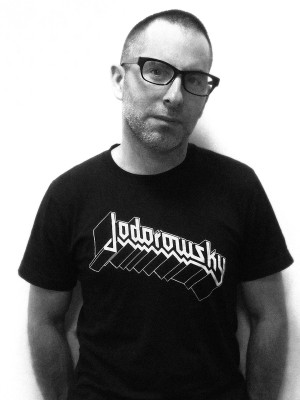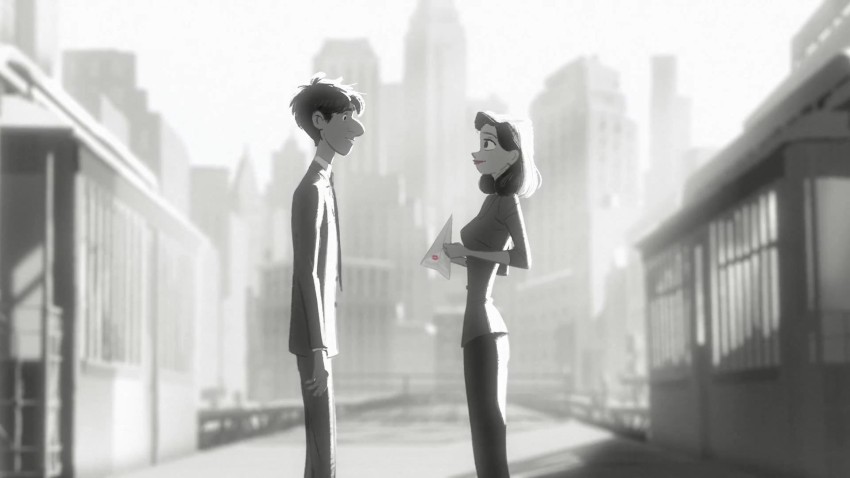Behind the Arias
October 24, 2016 · 0 comments
Andrew Osmond interviews the co-director of Harmony.
 Michael Arias should need little introduction to readers of this blog. He’s most famous as the American director of the epic anime film Tekkonkinkreet, whose production was the subject of an in-depth interview by Jasper Sharp. Arias is also the developer of the Toon Shaders software, as deployed on the Ghibli blockbusters Princess Mononoke and Spirited Away – you can read his comments on Toon Shaders here.
Michael Arias should need little introduction to readers of this blog. He’s most famous as the American director of the epic anime film Tekkonkinkreet, whose production was the subject of an in-depth interview by Jasper Sharp. Arias is also the developer of the Toon Shaders software, as deployed on the Ghibli blockbusters Princess Mononoke and Spirited Away – you can read his comments on Toon Shaders here.
But when Arias came to London this year to attend the MCM London Comic Con and the “Anime Weekend” at the BFI Southbank, we couldn’t resist interviewing him again. Below, we chat about Arias’ career, his thoughts on the anime industry, and his latest anime film – Harmony, based on a novel by the late Satoshi Ito, better known as Project Itoh.
 You’re a non-Japanese person who’s been able to develop and direct projects within Japanese animation. Looking back, what do you think were the main reasons why you were able to do this? Was it because you were recognised in the industry as a developer of groundbreaking software, or were there other factors?
You’re a non-Japanese person who’s been able to develop and direct projects within Japanese animation. Looking back, what do you think were the main reasons why you were able to do this? Was it because you were recognised in the industry as a developer of groundbreaking software, or were there other factors?
I guess there are a few reasons and I don’t know which would be the main one. I’d been living in Japan for many years already, always working in film and computer graphics, both on the creative and technical sides. I was working on the heels of the success of The Animatrix, which I produced. When it came to financing my own movie, and getting interest from studios, the success of The Animatrix was a pretty big factor. I knew and had close relationships with the people I wanted to work with, so that was also important.
You’ve directed Tekkonkinkreet and Harmony, which are both animated science fiction films based on Japanese books. Do you think Japanese science fiction tends to have a particular flavour or focus, compared to science-fiction from elsewhere?
No, actually there’s a wide range of science fiction, and not all of it is hard SF (I think Harmony is kind of hard SF). There’s a lot of stuff in literature and manga… Maybe there’s slightly less on display, just because Japan’s a small country, and because SF has a rich history outside Japan. I think Japanese SF is informed to a great extent by what’s happening outside Japan… It’s not really a homegrown art in that sense.
In terms of effects and technology, do you see Harmony as building on some of the achievements in Tekkonkinkreet?
Harmony is a pretty low-tech affair compared to Tekkonkinkreet. I would say it’s not really breaking lots of new ground technologically. At the same time, we’re working with a lot of the same animators and artists who worked on Tekkonkinkreet. There’s a knowledge base that we’re working with – call it “institutional” knowledge – that’s been very important in pulling off some of the shots. But the technology in Harmony was really applied just to get things done faster, rather than open up new avenues of storytelling.
Both Tekkonkinkreet and Harmony are very distinctive films. Did you make them with any particular target audience in mind (beyond the fans of the source material), or did you trust they would find their audiences?
I trusted they would find their audiences. In the case of Tekkonkinkreet, I was very much a fan myself, so I thought if I could make a movie that I was happy with, it would automatically connect with fans of the original. I wasn’t really even thinking of the audience… I thought of it as a personal project, even though it was huge.
 Harmony has a very strong element of social satire. I thought that insofar that it tries to answer some questions, or show possible answers to questions that confront Japanese society and the modern world, it was less important that Harmony really find an audience… I really just wanted to put it out there. I thought that [the original novel] is an important book and maybe a little underappreciated, so I thought of the film as documenting that, in a way. I really just trusted that it’s going to connect eventually with someone whom it needs to connect with.
Harmony has a very strong element of social satire. I thought that insofar that it tries to answer some questions, or show possible answers to questions that confront Japanese society and the modern world, it was less important that Harmony really find an audience… I really just wanted to put it out there. I thought that [the original novel] is an important book and maybe a little underappreciated, so I thought of the film as documenting that, in a way. I really just trusted that it’s going to connect eventually with someone whom it needs to connect with.
You produced Animatrix, which is seen as a landmark title in selling the “anime style” to a global audience. Today, how important do you think global audiences and foreign sales are to the people making anime in Japan?
I’m not sure how conscious producers of anime would be of audiences outside Japan. I think that to a certain extent the Japanese film industry, anime included, looks inward for its market, for better or worse. But I personally think the field outside Japan is enormously important to the industry, if it’s to survive.
You seem to prefer ‘small’ protagonists in your films, like the boys in Tekkonkinkreet and the girls in Harmony. What are your other likes and dislikes when you’re choosing a story for a project?
It’s true I’m very interested in children as characters, in the way they see the world. I tend to like tragic stories, for whatever reason; I’m really drawn to tragedy. Beyond that, it’s whatever I think of when I get out of bed in the morning. I tend to bounce around between hobbies and things that I’m into at any time.
About three years ago, I saw a wonderful presentation of Tekkonkinkreet at the Barbican Centre in London, with a live performance by Plaid. Were you able to see a live performance yourself?
Both times it was shown that way, at the Barbican and at the Sydney Opera House, Plaid invited me but I was unable to attend. I’ve seen video fragments of the events. I think it’s an enormously interesting avenue, and obviously music is such a big part of film. One of these days I’ll see it done live… I’ve heard rumours of a couple more upcoming live performances of Tekkonkinkreet.
 You said in one interview that it doesn’t make sense to use CG to mimic traditional animation. I wondered what you thought of titles such as Disney’s Paperman (above) and Production I.G’s Re Cyborg 009, which try to combine the appeals of traditional and computer animation.
You said in one interview that it doesn’t make sense to use CG to mimic traditional animation. I wondered what you thought of titles such as Disney’s Paperman (above) and Production I.G’s Re Cyborg 009, which try to combine the appeals of traditional and computer animation.
Paperman was quite interesting; I thought it actually wasn’t a simulation of traditional animation but a fascinating technical experiment that used a lot more handmade artistry than many 3D/traditional hybrids. My response to Re Cyborg 009 is that it would have been better hand-drawn.
In a making-of documentary for The Animatrix, you talk about the young animator Takeshi Koike finding his voice on the ‘World Record’ segment. How would you describe his significance as an artist? [Koike went on to direct Redline, and was character designer and animation director on Lupin the Third: The Woman Called Fujiko Mine.]
Yes, I spent a lot of time with Koike when we were doing Animatrix. I’ve stayed in touch with him and followed his work… I think he’s a really interesting Artist with a capital A, a guy who can do it all himself. His movies are almost monographs, more than they are collaborative efforts in the way of a lot of traditional animation… He’s got a really unique voice.
Animatrix was spun off from The Matrix, which was a Hollywood film which included homages to Ghost in the Shell. For this reason, I hope you’ll forgive me asking if you have any views on the upcoming live-action Hollywood remake of Ghost in the Shell, which is the subject of huge controversy.
Yes, I’m aware of the controversy. I know it’s an unpopular opinion, but I think the casting of a white woman as the lead character is kind of a non-issue. I don’t know if it would have been practically possible to finance the movie without casting an actress with a lot of box-office draw. On top of that, I felt that the Ghost in the Shell [anime] movie was made in a very culturally agnostic way. I don’t feel that it really demands an Asian cast. For that matter, Ghost in the Shell has characters who definitely look Caucasian… Unless it’s Grave of the Fireflies or something, who cares if the characters are white or Asian?
The fact that they’re able to make the movie at all seems a miracle to me. On the other hand, I’m not really too interested in watching the live-action adaptation. I already saw the Ghost in the Shell that I want to see and that’s enough for me. But as far as the casting goes, who cares?
Harmony is released in the UK by Anime Limited.
Leave a Reply